Rheumatoid Arthritis Assesment
VerifiedAdded on 2022/07/29
|8
|2275
|37
AI Summary
Please follow the instructions given in the assignment outline. -
Contribute Materials
Your contribution can guide someone’s learning journey. Share your
documents today.

Running head: RHEUMATOID ARTHRITIS
RHEUMATOID ARTHRITIS
Name:
Institution:
Course:
Professor:
Date submitted:
RHEUMATOID ARTHRITIS
Name:
Institution:
Course:
Professor:
Date submitted:
Secure Best Marks with AI Grader
Need help grading? Try our AI Grader for instant feedback on your assignments.
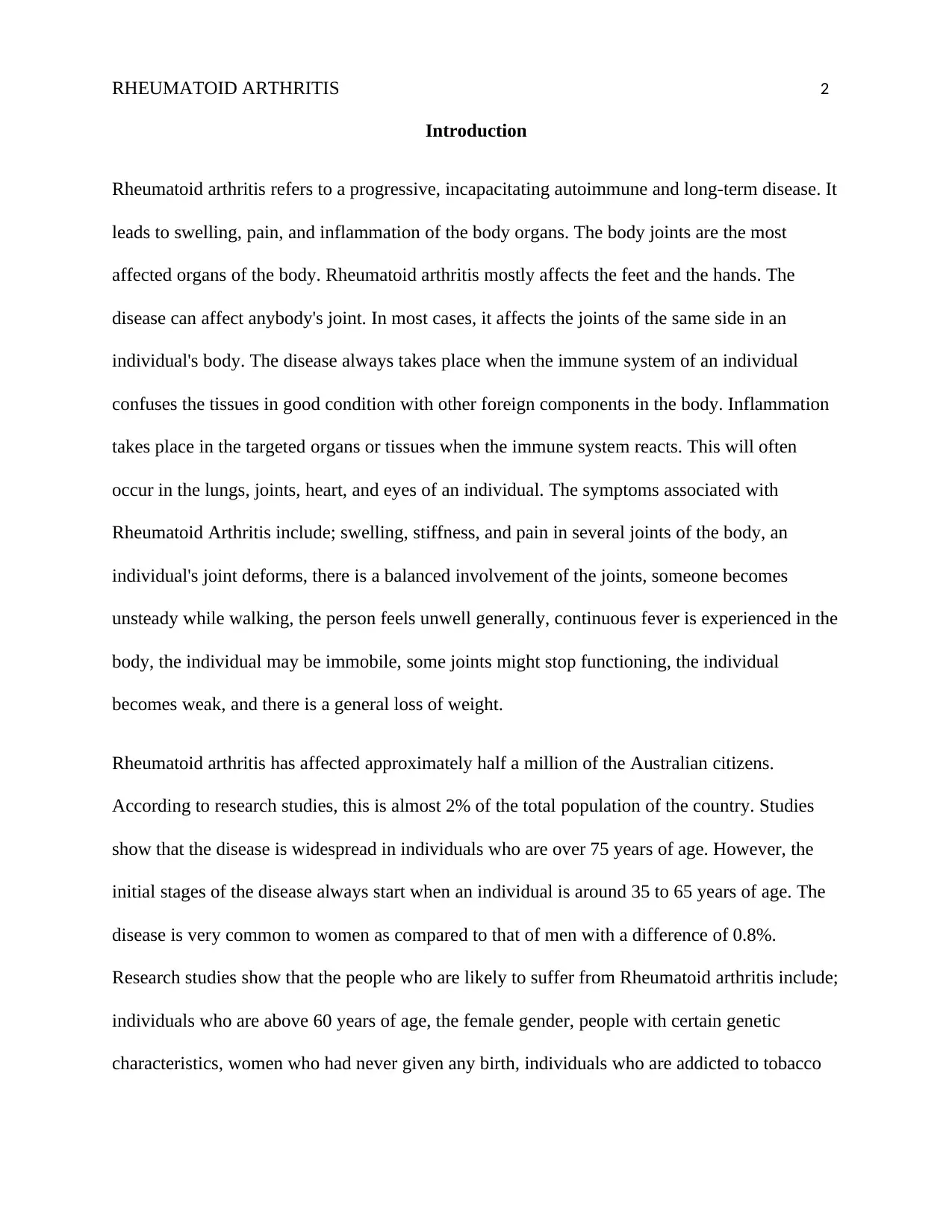
RHEUMATOID ARTHRITIS 2
Introduction
Rheumatoid arthritis refers to a progressive, incapacitating autoimmune and long-term disease. It
leads to swelling, pain, and inflammation of the body organs. The body joints are the most
affected organs of the body. Rheumatoid arthritis mostly affects the feet and the hands. The
disease can affect anybody's joint. In most cases, it affects the joints of the same side in an
individual's body. The disease always takes place when the immune system of an individual
confuses the tissues in good condition with other foreign components in the body. Inflammation
takes place in the targeted organs or tissues when the immune system reacts. This will often
occur in the lungs, joints, heart, and eyes of an individual. The symptoms associated with
Rheumatoid Arthritis include; swelling, stiffness, and pain in several joints of the body, an
individual's joint deforms, there is a balanced involvement of the joints, someone becomes
unsteady while walking, the person feels unwell generally, continuous fever is experienced in the
body, the individual may be immobile, some joints might stop functioning, the individual
becomes weak, and there is a general loss of weight.
Rheumatoid arthritis has affected approximately half a million of the Australian citizens.
According to research studies, this is almost 2% of the total population of the country. Studies
show that the disease is widespread in individuals who are over 75 years of age. However, the
initial stages of the disease always start when an individual is around 35 to 65 years of age. The
disease is very common to women as compared to that of men with a difference of 0.8%.
Research studies show that the people who are likely to suffer from Rheumatoid arthritis include;
individuals who are above 60 years of age, the female gender, people with certain genetic
characteristics, women who had never given any birth, individuals who are addicted to tobacco
Introduction
Rheumatoid arthritis refers to a progressive, incapacitating autoimmune and long-term disease. It
leads to swelling, pain, and inflammation of the body organs. The body joints are the most
affected organs of the body. Rheumatoid arthritis mostly affects the feet and the hands. The
disease can affect anybody's joint. In most cases, it affects the joints of the same side in an
individual's body. The disease always takes place when the immune system of an individual
confuses the tissues in good condition with other foreign components in the body. Inflammation
takes place in the targeted organs or tissues when the immune system reacts. This will often
occur in the lungs, joints, heart, and eyes of an individual. The symptoms associated with
Rheumatoid Arthritis include; swelling, stiffness, and pain in several joints of the body, an
individual's joint deforms, there is a balanced involvement of the joints, someone becomes
unsteady while walking, the person feels unwell generally, continuous fever is experienced in the
body, the individual may be immobile, some joints might stop functioning, the individual
becomes weak, and there is a general loss of weight.
Rheumatoid arthritis has affected approximately half a million of the Australian citizens.
According to research studies, this is almost 2% of the total population of the country. Studies
show that the disease is widespread in individuals who are over 75 years of age. However, the
initial stages of the disease always start when an individual is around 35 to 65 years of age. The
disease is very common to women as compared to that of men with a difference of 0.8%.
Research studies show that the people who are likely to suffer from Rheumatoid arthritis include;
individuals who are above 60 years of age, the female gender, people with certain genetic
characteristics, women who had never given any birth, individuals who are addicted to tobacco
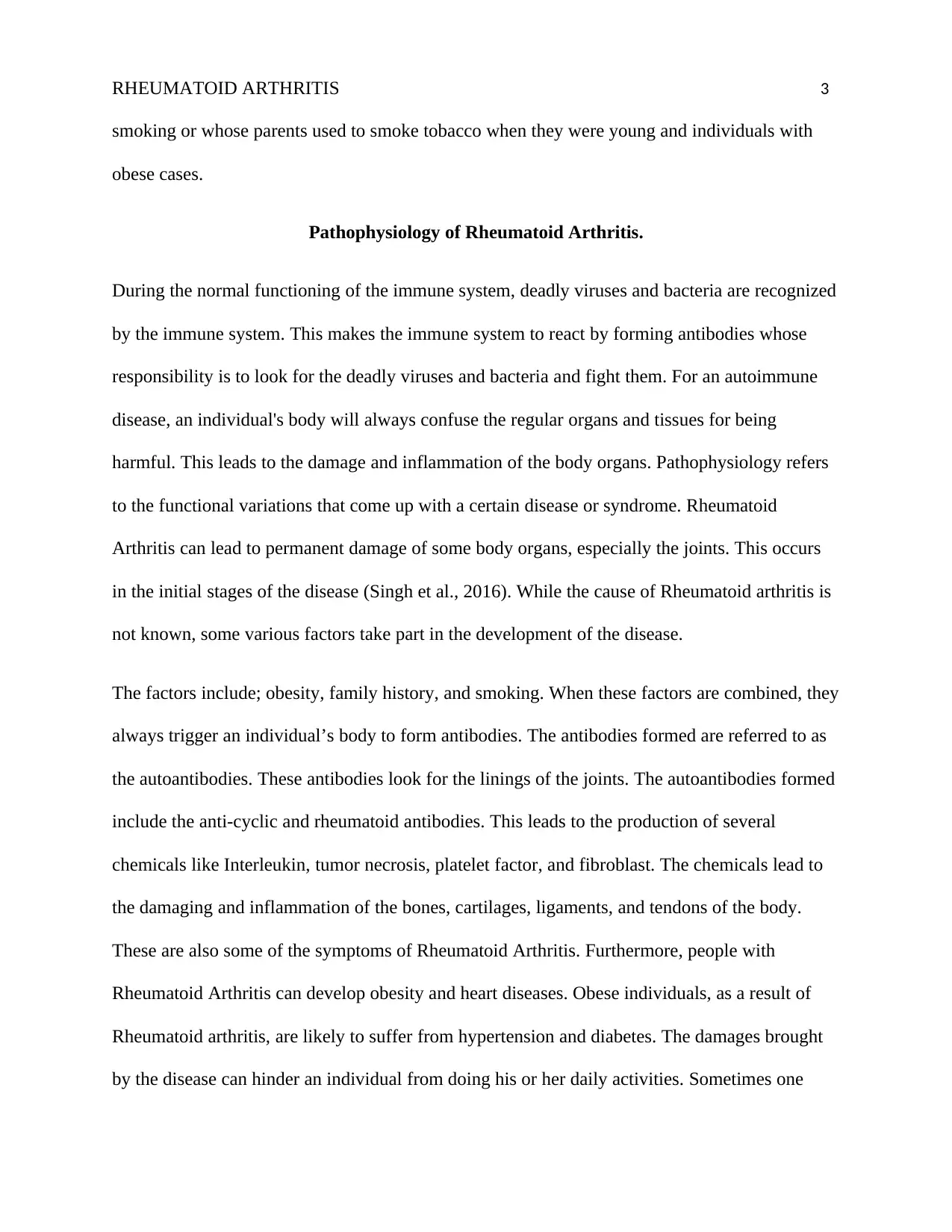
RHEUMATOID ARTHRITIS 3
smoking or whose parents used to smoke tobacco when they were young and individuals with
obese cases.
Pathophysiology of Rheumatoid Arthritis.
During the normal functioning of the immune system, deadly viruses and bacteria are recognized
by the immune system. This makes the immune system to react by forming antibodies whose
responsibility is to look for the deadly viruses and bacteria and fight them. For an autoimmune
disease, an individual's body will always confuse the regular organs and tissues for being
harmful. This leads to the damage and inflammation of the body organs. Pathophysiology refers
to the functional variations that come up with a certain disease or syndrome. Rheumatoid
Arthritis can lead to permanent damage of some body organs, especially the joints. This occurs
in the initial stages of the disease (Singh et al., 2016). While the cause of Rheumatoid arthritis is
not known, some various factors take part in the development of the disease.
The factors include; obesity, family history, and smoking. When these factors are combined, they
always trigger an individual’s body to form antibodies. The antibodies formed are referred to as
the autoantibodies. These antibodies look for the linings of the joints. The autoantibodies formed
include the anti-cyclic and rheumatoid antibodies. This leads to the production of several
chemicals like Interleukin, tumor necrosis, platelet factor, and fibroblast. The chemicals lead to
the damaging and inflammation of the bones, cartilages, ligaments, and tendons of the body.
These are also some of the symptoms of Rheumatoid Arthritis. Furthermore, people with
Rheumatoid Arthritis can develop obesity and heart diseases. Obese individuals, as a result of
Rheumatoid arthritis, are likely to suffer from hypertension and diabetes. The damages brought
by the disease can hinder an individual from doing his or her daily activities. Sometimes one
smoking or whose parents used to smoke tobacco when they were young and individuals with
obese cases.
Pathophysiology of Rheumatoid Arthritis.
During the normal functioning of the immune system, deadly viruses and bacteria are recognized
by the immune system. This makes the immune system to react by forming antibodies whose
responsibility is to look for the deadly viruses and bacteria and fight them. For an autoimmune
disease, an individual's body will always confuse the regular organs and tissues for being
harmful. This leads to the damage and inflammation of the body organs. Pathophysiology refers
to the functional variations that come up with a certain disease or syndrome. Rheumatoid
Arthritis can lead to permanent damage of some body organs, especially the joints. This occurs
in the initial stages of the disease (Singh et al., 2016). While the cause of Rheumatoid arthritis is
not known, some various factors take part in the development of the disease.
The factors include; obesity, family history, and smoking. When these factors are combined, they
always trigger an individual’s body to form antibodies. The antibodies formed are referred to as
the autoantibodies. These antibodies look for the linings of the joints. The autoantibodies formed
include the anti-cyclic and rheumatoid antibodies. This leads to the production of several
chemicals like Interleukin, tumor necrosis, platelet factor, and fibroblast. The chemicals lead to
the damaging and inflammation of the bones, cartilages, ligaments, and tendons of the body.
These are also some of the symptoms of Rheumatoid Arthritis. Furthermore, people with
Rheumatoid Arthritis can develop obesity and heart diseases. Obese individuals, as a result of
Rheumatoid arthritis, are likely to suffer from hypertension and diabetes. The damages brought
by the disease can hinder an individual from doing his or her daily activities. Sometimes one

RHEUMATOID ARTHRITIS 4
cannot predict the disease. This can lead to stress, anxiety, and depression. The victim might
have difficulties with employment. Furthermore, several conditions might come up as a result of
this. They include; inflammation of the heart, lungs, the eyes and other body parts, there is also a
rapture of the tendons, there is myelopathy of the cervix, someone might also develop colds and
vasculitis (Smolet et al., 2017).
Pharmacological treatment of Rheumatoid Arthritis.
It is difficult for many doctors to give a diagnosis for Rheumatoid Arthritis at its initial stages
because it resembles other diseases. Nevertheless, the continuity of this disease can be slowed
down when the treatment of the disease starts early (Skolove, 2018). Research studies suggest
that the disease should be diagnosed when the disease is just six months old. The medical expert
will always look at the clinical results of inflammations caused in the body and ask for the period
at which the symptoms have been occurring. Sometimes an examination of the physical body
may be done. This involves checking the functional limitations, deformity, and swellings. The
medical expert will, therefore, recommend some tests.
The first test can be a blood test. The blood test involves the testing of the rate of erythrocyte
sedimentation, Anemia, and rheumatoid factor. Many victims of Rheumatoid Arthritis may
suffer from Anemia. Anemia is always as a result of insufficient red blood cells in the body
(McInnes & Schett, 2017). Imaging and x-rays might also be done to the victims. This will
always help the medical expert to know the kind of arthritis the patient is suffering from and
being able to monitor the progression of the disease over a while. Research studies show that
some drugs might be used to reduce symptoms and lower down the progression of the disease.
This includes Nonsteroidal drugs, Corticosteroids, and other modifying drugs for the disease.
cannot predict the disease. This can lead to stress, anxiety, and depression. The victim might
have difficulties with employment. Furthermore, several conditions might come up as a result of
this. They include; inflammation of the heart, lungs, the eyes and other body parts, there is also a
rapture of the tendons, there is myelopathy of the cervix, someone might also develop colds and
vasculitis (Smolet et al., 2017).
Pharmacological treatment of Rheumatoid Arthritis.
It is difficult for many doctors to give a diagnosis for Rheumatoid Arthritis at its initial stages
because it resembles other diseases. Nevertheless, the continuity of this disease can be slowed
down when the treatment of the disease starts early (Skolove, 2018). Research studies suggest
that the disease should be diagnosed when the disease is just six months old. The medical expert
will always look at the clinical results of inflammations caused in the body and ask for the period
at which the symptoms have been occurring. Sometimes an examination of the physical body
may be done. This involves checking the functional limitations, deformity, and swellings. The
medical expert will, therefore, recommend some tests.
The first test can be a blood test. The blood test involves the testing of the rate of erythrocyte
sedimentation, Anemia, and rheumatoid factor. Many victims of Rheumatoid Arthritis may
suffer from Anemia. Anemia is always as a result of insufficient red blood cells in the body
(McInnes & Schett, 2017). Imaging and x-rays might also be done to the victims. This will
always help the medical expert to know the kind of arthritis the patient is suffering from and
being able to monitor the progression of the disease over a while. Research studies show that
some drugs might be used to reduce symptoms and lower down the progression of the disease.
This includes Nonsteroidal drugs, Corticosteroids, and other modifying drugs for the disease.
Secure Best Marks with AI Grader
Need help grading? Try our AI Grader for instant feedback on your assignments.
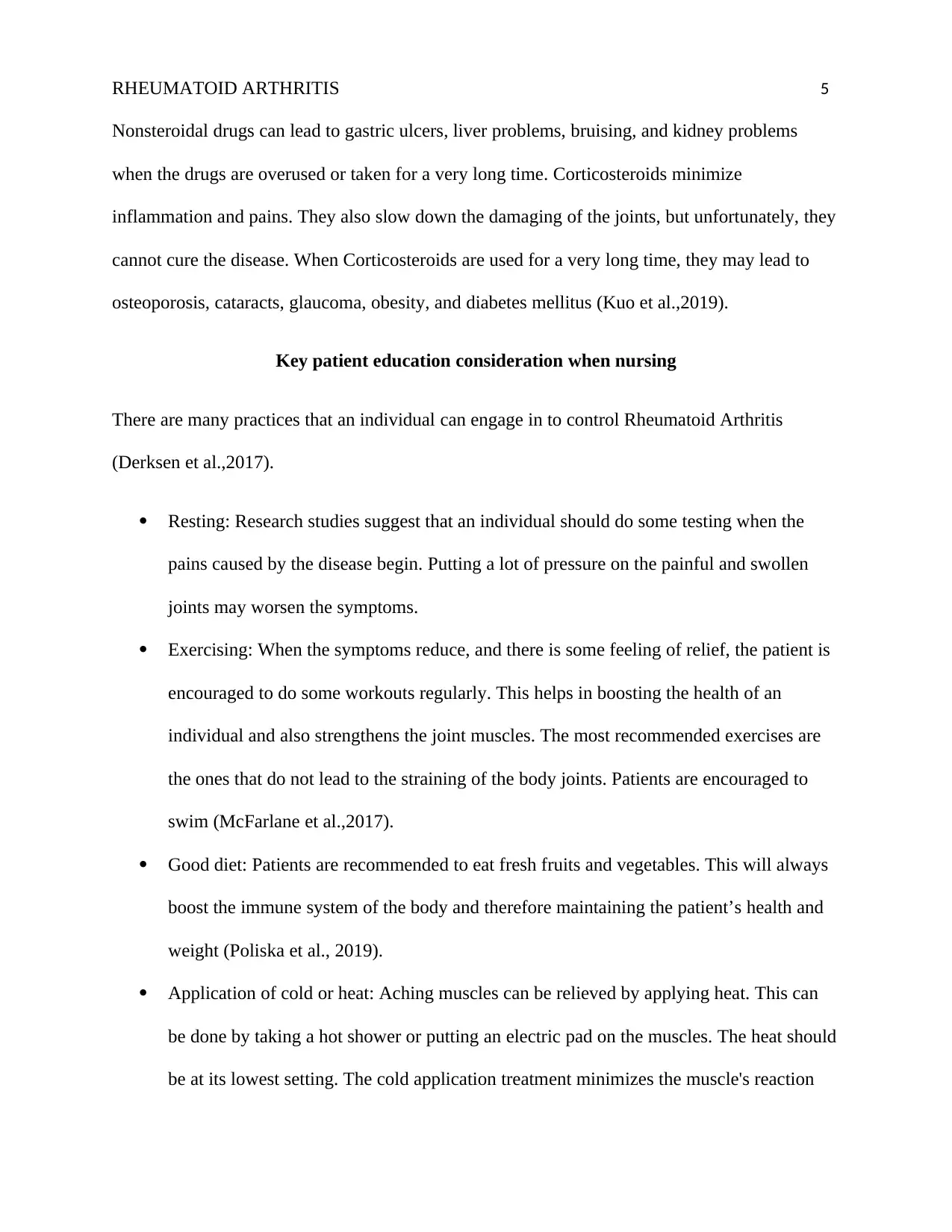
RHEUMATOID ARTHRITIS 5
Nonsteroidal drugs can lead to gastric ulcers, liver problems, bruising, and kidney problems
when the drugs are overused or taken for a very long time. Corticosteroids minimize
inflammation and pains. They also slow down the damaging of the joints, but unfortunately, they
cannot cure the disease. When Corticosteroids are used for a very long time, they may lead to
osteoporosis, cataracts, glaucoma, obesity, and diabetes mellitus (Kuo et al.,2019).
Key patient education consideration when nursing
There are many practices that an individual can engage in to control Rheumatoid Arthritis
(Derksen et al.,2017).
Resting: Research studies suggest that an individual should do some testing when the
pains caused by the disease begin. Putting a lot of pressure on the painful and swollen
joints may worsen the symptoms.
Exercising: When the symptoms reduce, and there is some feeling of relief, the patient is
encouraged to do some workouts regularly. This helps in boosting the health of an
individual and also strengthens the joint muscles. The most recommended exercises are
the ones that do not lead to the straining of the body joints. Patients are encouraged to
swim (McFarlane et al.,2017).
Good diet: Patients are recommended to eat fresh fruits and vegetables. This will always
boost the immune system of the body and therefore maintaining the patient’s health and
weight (Poliska et al., 2019).
Application of cold or heat: Aching muscles can be relieved by applying heat. This can
be done by taking a hot shower or putting an electric pad on the muscles. The heat should
be at its lowest setting. The cold application treatment minimizes the muscle's reaction
Nonsteroidal drugs can lead to gastric ulcers, liver problems, bruising, and kidney problems
when the drugs are overused or taken for a very long time. Corticosteroids minimize
inflammation and pains. They also slow down the damaging of the joints, but unfortunately, they
cannot cure the disease. When Corticosteroids are used for a very long time, they may lead to
osteoporosis, cataracts, glaucoma, obesity, and diabetes mellitus (Kuo et al.,2019).
Key patient education consideration when nursing
There are many practices that an individual can engage in to control Rheumatoid Arthritis
(Derksen et al.,2017).
Resting: Research studies suggest that an individual should do some testing when the
pains caused by the disease begin. Putting a lot of pressure on the painful and swollen
joints may worsen the symptoms.
Exercising: When the symptoms reduce, and there is some feeling of relief, the patient is
encouraged to do some workouts regularly. This helps in boosting the health of an
individual and also strengthens the joint muscles. The most recommended exercises are
the ones that do not lead to the straining of the body joints. Patients are encouraged to
swim (McFarlane et al.,2017).
Good diet: Patients are recommended to eat fresh fruits and vegetables. This will always
boost the immune system of the body and therefore maintaining the patient’s health and
weight (Poliska et al., 2019).
Application of cold or heat: Aching muscles can be relieved by applying heat. This can
be done by taking a hot shower or putting an electric pad on the muscles. The heat should
be at its lowest setting. The cold application treatment minimizes the muscle's reaction
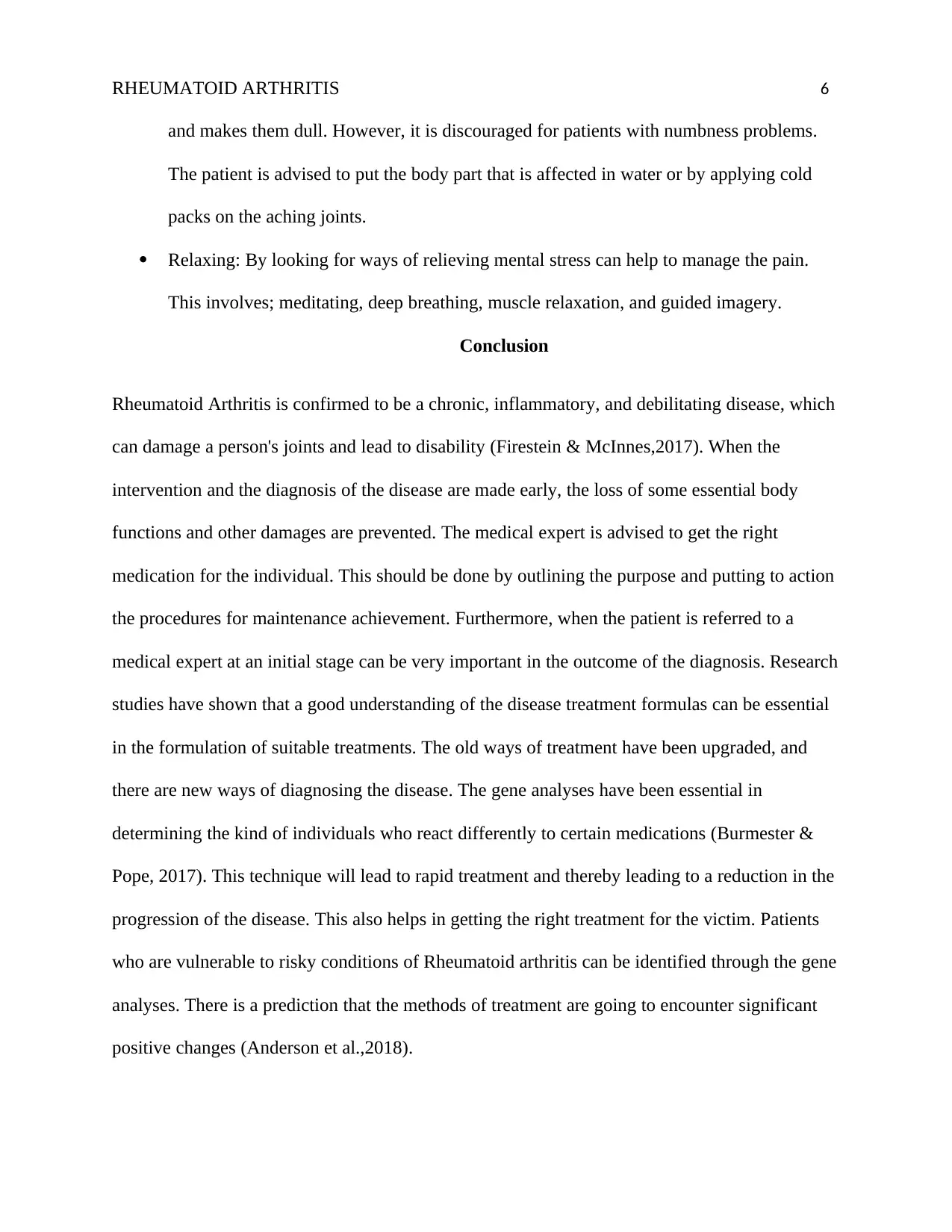
RHEUMATOID ARTHRITIS 6
and makes them dull. However, it is discouraged for patients with numbness problems.
The patient is advised to put the body part that is affected in water or by applying cold
packs on the aching joints.
Relaxing: By looking for ways of relieving mental stress can help to manage the pain.
This involves; meditating, deep breathing, muscle relaxation, and guided imagery.
Conclusion
Rheumatoid Arthritis is confirmed to be a chronic, inflammatory, and debilitating disease, which
can damage a person's joints and lead to disability (Firestein & McInnes,2017). When the
intervention and the diagnosis of the disease are made early, the loss of some essential body
functions and other damages are prevented. The medical expert is advised to get the right
medication for the individual. This should be done by outlining the purpose and putting to action
the procedures for maintenance achievement. Furthermore, when the patient is referred to a
medical expert at an initial stage can be very important in the outcome of the diagnosis. Research
studies have shown that a good understanding of the disease treatment formulas can be essential
in the formulation of suitable treatments. The old ways of treatment have been upgraded, and
there are new ways of diagnosing the disease. The gene analyses have been essential in
determining the kind of individuals who react differently to certain medications (Burmester &
Pope, 2017). This technique will lead to rapid treatment and thereby leading to a reduction in the
progression of the disease. This also helps in getting the right treatment for the victim. Patients
who are vulnerable to risky conditions of Rheumatoid arthritis can be identified through the gene
analyses. There is a prediction that the methods of treatment are going to encounter significant
positive changes (Anderson et al.,2018).
and makes them dull. However, it is discouraged for patients with numbness problems.
The patient is advised to put the body part that is affected in water or by applying cold
packs on the aching joints.
Relaxing: By looking for ways of relieving mental stress can help to manage the pain.
This involves; meditating, deep breathing, muscle relaxation, and guided imagery.
Conclusion
Rheumatoid Arthritis is confirmed to be a chronic, inflammatory, and debilitating disease, which
can damage a person's joints and lead to disability (Firestein & McInnes,2017). When the
intervention and the diagnosis of the disease are made early, the loss of some essential body
functions and other damages are prevented. The medical expert is advised to get the right
medication for the individual. This should be done by outlining the purpose and putting to action
the procedures for maintenance achievement. Furthermore, when the patient is referred to a
medical expert at an initial stage can be very important in the outcome of the diagnosis. Research
studies have shown that a good understanding of the disease treatment formulas can be essential
in the formulation of suitable treatments. The old ways of treatment have been upgraded, and
there are new ways of diagnosing the disease. The gene analyses have been essential in
determining the kind of individuals who react differently to certain medications (Burmester &
Pope, 2017). This technique will lead to rapid treatment and thereby leading to a reduction in the
progression of the disease. This also helps in getting the right treatment for the victim. Patients
who are vulnerable to risky conditions of Rheumatoid arthritis can be identified through the gene
analyses. There is a prediction that the methods of treatment are going to encounter significant
positive changes (Anderson et al.,2018).
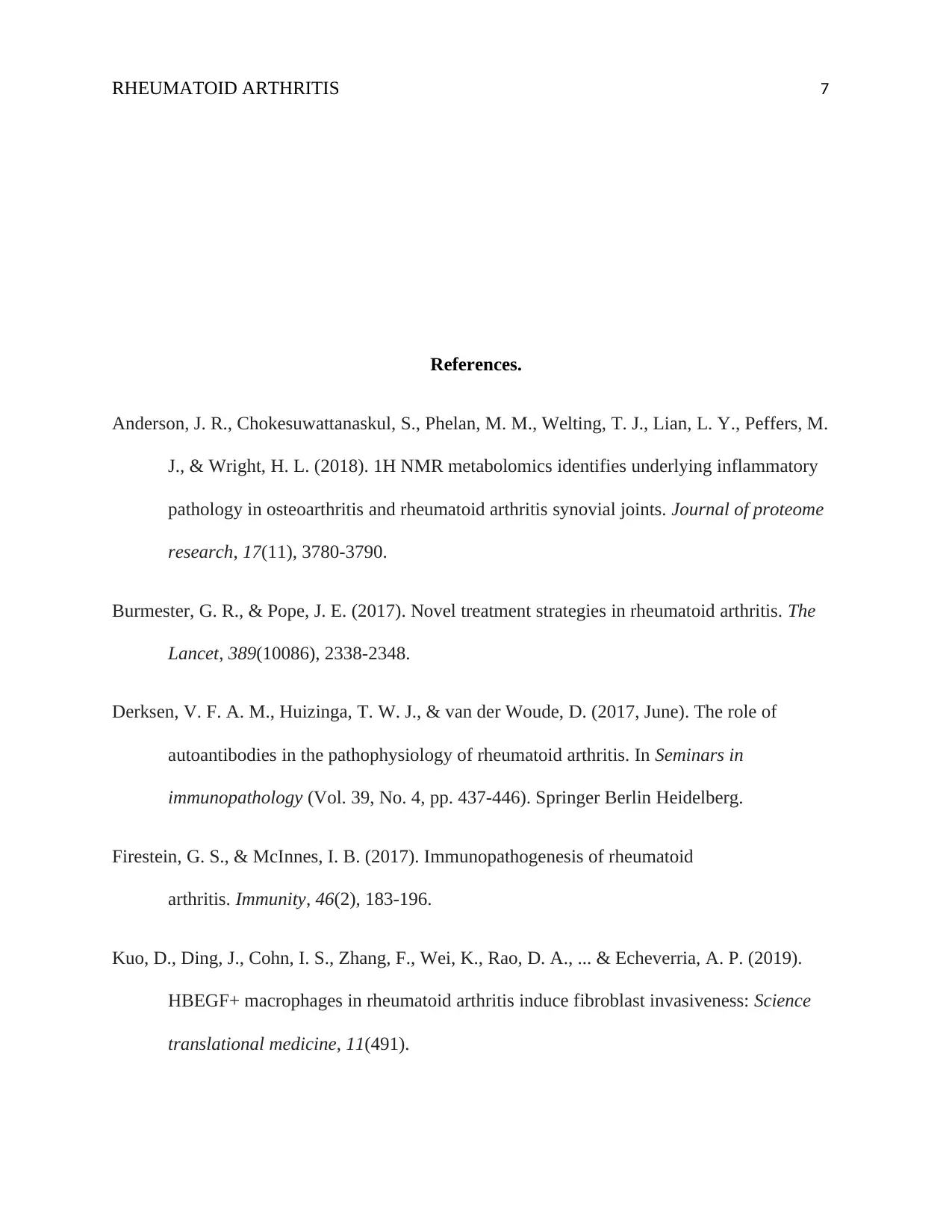
RHEUMATOID ARTHRITIS 7
References.
Anderson, J. R., Chokesuwattanaskul, S., Phelan, M. M., Welting, T. J., Lian, L. Y., Peffers, M.
J., & Wright, H. L. (2018). 1H NMR metabolomics identifies underlying inflammatory
pathology in osteoarthritis and rheumatoid arthritis synovial joints. Journal of proteome
research, 17(11), 3780-3790.
Burmester, G. R., & Pope, J. E. (2017). Novel treatment strategies in rheumatoid arthritis. The
Lancet, 389(10086), 2338-2348.
Derksen, V. F. A. M., Huizinga, T. W. J., & van der Woude, D. (2017, June). The role of
autoantibodies in the pathophysiology of rheumatoid arthritis. In Seminars in
immunopathology (Vol. 39, No. 4, pp. 437-446). Springer Berlin Heidelberg.
Firestein, G. S., & McInnes, I. B. (2017). Immunopathogenesis of rheumatoid
arthritis. Immunity, 46(2), 183-196.
Kuo, D., Ding, J., Cohn, I. S., Zhang, F., Wei, K., Rao, D. A., ... & Echeverria, A. P. (2019).
HBEGF+ macrophages in rheumatoid arthritis induce fibroblast invasiveness: Science
translational medicine, 11(491).
References.
Anderson, J. R., Chokesuwattanaskul, S., Phelan, M. M., Welting, T. J., Lian, L. Y., Peffers, M.
J., & Wright, H. L. (2018). 1H NMR metabolomics identifies underlying inflammatory
pathology in osteoarthritis and rheumatoid arthritis synovial joints. Journal of proteome
research, 17(11), 3780-3790.
Burmester, G. R., & Pope, J. E. (2017). Novel treatment strategies in rheumatoid arthritis. The
Lancet, 389(10086), 2338-2348.
Derksen, V. F. A. M., Huizinga, T. W. J., & van der Woude, D. (2017, June). The role of
autoantibodies in the pathophysiology of rheumatoid arthritis. In Seminars in
immunopathology (Vol. 39, No. 4, pp. 437-446). Springer Berlin Heidelberg.
Firestein, G. S., & McInnes, I. B. (2017). Immunopathogenesis of rheumatoid
arthritis. Immunity, 46(2), 183-196.
Kuo, D., Ding, J., Cohn, I. S., Zhang, F., Wei, K., Rao, D. A., ... & Echeverria, A. P. (2019).
HBEGF+ macrophages in rheumatoid arthritis induce fibroblast invasiveness: Science
translational medicine, 11(491).
Paraphrase This Document
Need a fresh take? Get an instant paraphrase of this document with our AI Paraphraser
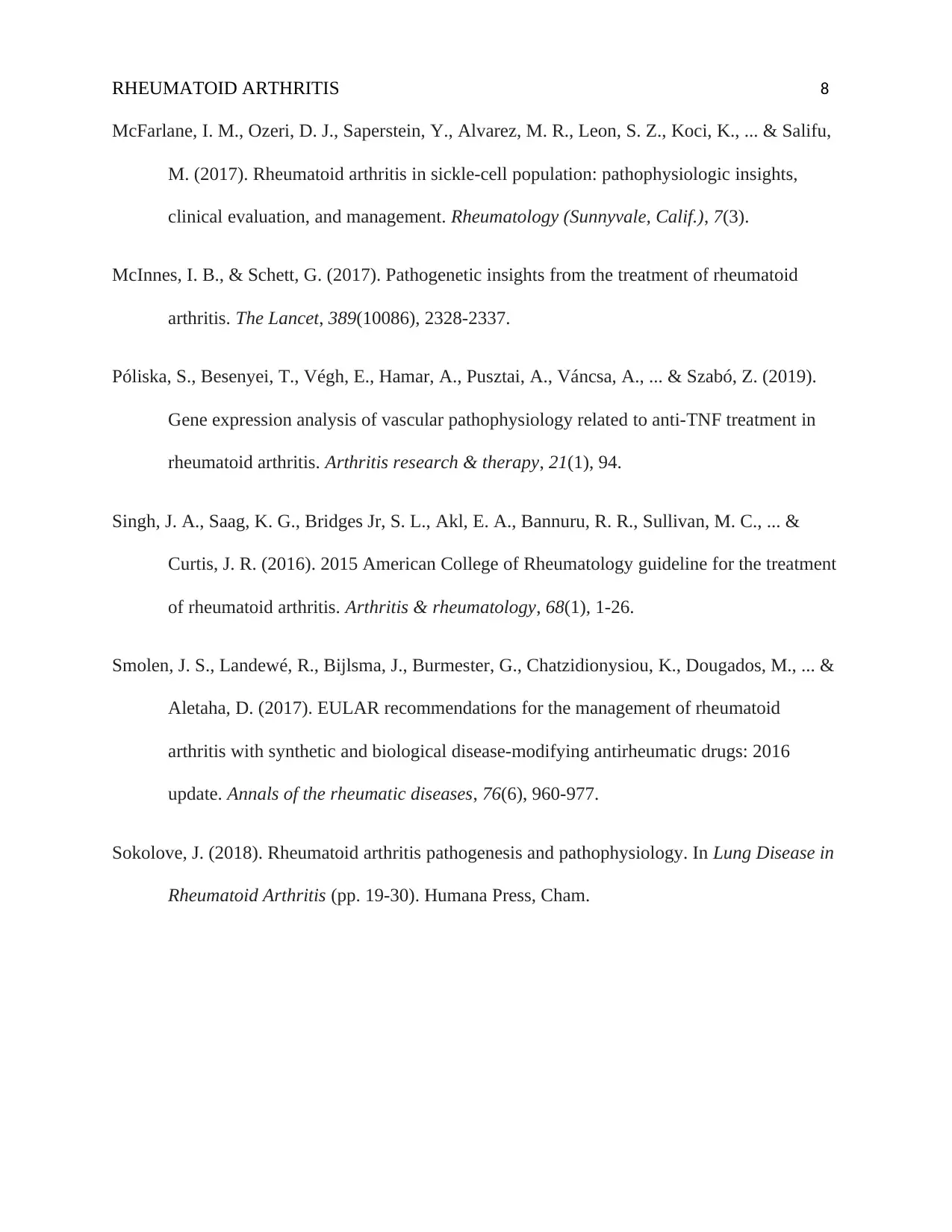
RHEUMATOID ARTHRITIS 8
McFarlane, I. M., Ozeri, D. J., Saperstein, Y., Alvarez, M. R., Leon, S. Z., Koci, K., ... & Salifu,
M. (2017). Rheumatoid arthritis in sickle-cell population: pathophysiologic insights,
clinical evaluation, and management. Rheumatology (Sunnyvale, Calif.), 7(3).
McInnes, I. B., & Schett, G. (2017). Pathogenetic insights from the treatment of rheumatoid
arthritis. The Lancet, 389(10086), 2328-2337.
Póliska, S., Besenyei, T., Végh, E., Hamar, A., Pusztai, A., Váncsa, A., ... & Szabó, Z. (2019).
Gene expression analysis of vascular pathophysiology related to anti-TNF treatment in
rheumatoid arthritis. Arthritis research & therapy, 21(1), 94.
Singh, J. A., Saag, K. G., Bridges Jr, S. L., Akl, E. A., Bannuru, R. R., Sullivan, M. C., ... &
Curtis, J. R. (2016). 2015 American College of Rheumatology guideline for the treatment
of rheumatoid arthritis. Arthritis & rheumatology, 68(1), 1-26.
Smolen, J. S., Landewé, R., Bijlsma, J., Burmester, G., Chatzidionysiou, K., Dougados, M., ... &
Aletaha, D. (2017). EULAR recommendations for the management of rheumatoid
arthritis with synthetic and biological disease-modifying antirheumatic drugs: 2016
update. Annals of the rheumatic diseases, 76(6), 960-977.
Sokolove, J. (2018). Rheumatoid arthritis pathogenesis and pathophysiology. In Lung Disease in
Rheumatoid Arthritis (pp. 19-30). Humana Press, Cham.
McFarlane, I. M., Ozeri, D. J., Saperstein, Y., Alvarez, M. R., Leon, S. Z., Koci, K., ... & Salifu,
M. (2017). Rheumatoid arthritis in sickle-cell population: pathophysiologic insights,
clinical evaluation, and management. Rheumatology (Sunnyvale, Calif.), 7(3).
McInnes, I. B., & Schett, G. (2017). Pathogenetic insights from the treatment of rheumatoid
arthritis. The Lancet, 389(10086), 2328-2337.
Póliska, S., Besenyei, T., Végh, E., Hamar, A., Pusztai, A., Váncsa, A., ... & Szabó, Z. (2019).
Gene expression analysis of vascular pathophysiology related to anti-TNF treatment in
rheumatoid arthritis. Arthritis research & therapy, 21(1), 94.
Singh, J. A., Saag, K. G., Bridges Jr, S. L., Akl, E. A., Bannuru, R. R., Sullivan, M. C., ... &
Curtis, J. R. (2016). 2015 American College of Rheumatology guideline for the treatment
of rheumatoid arthritis. Arthritis & rheumatology, 68(1), 1-26.
Smolen, J. S., Landewé, R., Bijlsma, J., Burmester, G., Chatzidionysiou, K., Dougados, M., ... &
Aletaha, D. (2017). EULAR recommendations for the management of rheumatoid
arthritis with synthetic and biological disease-modifying antirheumatic drugs: 2016
update. Annals of the rheumatic diseases, 76(6), 960-977.
Sokolove, J. (2018). Rheumatoid arthritis pathogenesis and pathophysiology. In Lung Disease in
Rheumatoid Arthritis (pp. 19-30). Humana Press, Cham.
1 out of 8
Related Documents
Your All-in-One AI-Powered Toolkit for Academic Success.
+13062052269
info@desklib.com
Available 24*7 on WhatsApp / Email
![[object Object]](/_next/static/media/star-bottom.7253800d.svg)
Unlock your academic potential
© 2024 | Zucol Services PVT LTD | All rights reserved.





